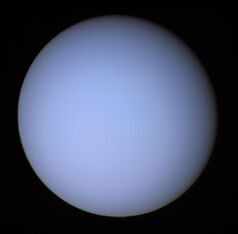
Uranus, an example of an Ice giant
An ice giant is a type of giant planet, composed largely of materials less volatile than hydrogen and helium. It became known around the 1990's that Uranus and Neptune were really a distinct class of gas giants and giant planets, as both are composed of about 20% hydrogen, compared to the heavier gas giant's 90%. They are primarily composed of 'ices' - volatile substances heavier than hydrogen and helium. These materials were actually ices during the ice giants' formation, but now they exist in different phases, primarily supercritical fluids. The 'ice' is primarily H2O and is generally treated as such, making the equation of state of water important for modeling ice giants. Ice giants are also though to lack metallic hydrogen at their cores, unlike the gas giants.
Different atmospheric patterns have been observed, including polar vortices, strong zonal winds, and large-scale circulation. There currently isn't any satifying model that describes why these features exist. Because of their large sizes and low thermal conductivities, planetary interior pressures range up to several 100 GPa and temperatures of several 1000 Kelvin. In March 2012, it was found that the compressibility of water used in ice-giant models could be off by one third. The value is important for modeling ice giants, and has a ripple effect understanding them.
Currently known ice giants include Uranus, Neptune, and certain extrasolar planets.
Formation of ice giants[]
The ice giants have gas envelopes that are smaller than those of the gas giants Jupiter and Saturn, but are still substantial (several Earth masses). The existence of these envelopes provides a critical constraint: giant planets must form relatively quickly, before the gas in the protoplanetary disk is dissipated. Observations of protoplanetary disks around stars in young clusters pin the gas disk lifetime around the 3 - 10 million year range.
Magnetic fields[]
Both the magnetic fields of Uranus and Neptune are unusually displaced and tilted. Their field strengths are intermediate between those of the gas giants Jupiter and Saturn and those of the terrestrial planets; being 50 and 25 times that of Earth's, respectively. Their magnetic fields are believed to originate in an ionized convecting molten ice mantle.